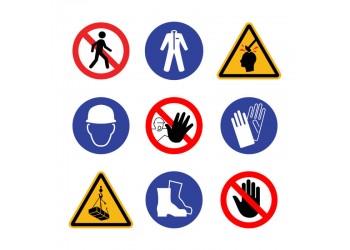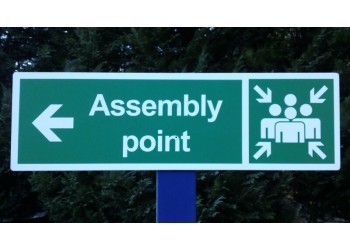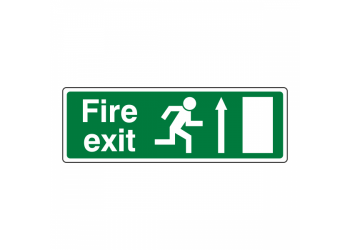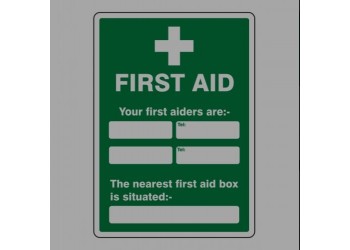In the bustling environment of a building site, communication is critical. This blog post aims to unravel the complex language of building site signs, breaking down their key messages for site managers and safety officers.
With a focus on self-adhesive vinyl and rigid plastic signs, we’ll explore their importance, regulations, and how to interpret their symbols and colours.
The Importance of Building Site Signs
Building site signs are crucial tools in maintaining safety standards. They serve as silent communicators, alerting workers to potential hazards and providing essential instructions.
Understanding the Role of Signs
Building site signs play a critical role in maintaining safety standards on construction sites. They are instrumental in guiding workers, providing instructions, and alerting them about potential dangers. These signs serve as silent communicators, effectively transcending language barriers with their universally recognised symbols.
They Guide Workers
Building site signs help navigate the complex environment of a construction site, directing workers to safe paths and highlighting restricted areas. They can indicate the location of essential amenities like first aid stations and fire exits.
Provide Instructions
Signs also provide specific instructions to ensure safety protocols are followed. For example, they may instruct workers to wear protective equipment in certain areas or follow specific procedures when operating machinery.
Alert About Potential Dangers
Most importantly, building site signs alert workers about potential dangers, from hazardous materials to heavy machinery operations. They warn about potential threats, allowing workers to take necessary precautions.
Compliance with Regulations
These signs are crucial in maintaining safety standards and fostering a safety-conscious working environment.
Signs Are a Legal Requirement on UK Building Sites
Building site signs are more than just good practice; they’re a legal requirement in the UK. Failure to comply can result in significant penalties, including fines and potential shutdowns. The Health and Safety (Safety Signs and Signals) Regulations 1996 mandates using safety signs where there is a significant risk that can’t be avoided or controlled by other means.
This includes signs indicating potential hazards, mandatory actions, prohibited actions, and safety measures. The signs must be clear, legible, and understandable to all workers, regardless of their language skills.
Proper use and Understanding Fosters a Safety-Conscious Working Environment
Proper use and understanding of building site signs are vital in fostering a safety-conscious working environment.
Regular training sessions should be conducted to ensure that all workers understand the meaning and importance of the signs. These sessions can also reinforce the company’s commitment to safety. The Royal Society for the Prevention of Accidents offers resources and training materials to help businesses improve their safety culture.
In summary, building site signs are critical in maintaining safety and compliance with regulations on construction sites. They guide workers, provide necessary instructions, and alert them about potential dangers. These signs serve as universal communicators, transcending language barriers.
In the UK, they’re a legal requirement under the Health and Safety (Safety Signs and Signals) Regulations 1996 to mitigate risks. A proper understanding of these signs fosters a safety-conscious environment. Training sessions should be conducted to ensure workers understand the importance and meaning of these signs.
The Language of Symbols
Symbols on building site signs communicate critical messages instantly, transcending language barriers.
Warning Symbols
Warning symbols on building site signs are crucial in communicating potential hazards. They instantly convey critical messages to workers, even transcending language barriers.
Indicate Potential Hazards
Warning symbols are used to indicate potential hazards that may be present on a construction site. For example, a sign with an exclamation mark within a triangle is a universal caution symbol. These signs are often yellow or amber, drawing attention and indicating caution.
Examples Include Falling Objects or Heavy Machinery
Specific symbols are used to denote particular hazards. For instance, a sign showing an object in mid-air might indicate the risk of falling objects. Similarly, a sign with a bulldozer pictogram warns about heavy machinery’s presence.
Prohibition Symbols
Prohibition symbols on building site signs play a crucial role in ensuring safety. They communicate forbidden actions, helping to prevent accidents and maintain a safe working environment.
Communicate Forbidden Actions
A red circle with a diagonal line usually represents prohibition symbols. They communicate actions that are not allowed, such as entering restricted areas or using specific equipment without proper safety gear. Understanding these symbols is vital for all workers.
Examples Include No Smoking or No Access
Some common examples of prohibition symbols include no smoking and no access signs. These signs help enforce essential safety protocols, preventing activities that could risk health and safety. No smoking signs, for instance, are crucial in areas with flammable materials.
In summary, the Language of Symbols in the context of building site signs is a critical communication tool that transcends language barriers.
Warning symbols are universally recognised and indicate potential hazards, such as falling objects or heavy machinery. These signs are often yellow or amber, meaning caution. Prohibition symbols, represented by a red circle with a diagonal line, communicate forbidden actions like smoking or accessing restricted areas.
This symbolic language enforces safety protocols and helps maintain a safe working environment.
Decoding Colour Codes
Colours on building site signs are not arbitrary; each colour signifies a specific type of message.
Red
Red is essential in the context of safety signs, particularly on construction sites. It is universally associated with prohibitive actions and fire safety measures, immediately drawing attention and signalling a need for caution.
Prohibition and Fire Safety
Red is commonly used in building site signs to indicate prohibition and fire safety. The colour’s striking visibility helps workers easily identify prohibited actions or areas on the site, such as no entry zones or no smoking areas.
Additionally, fire safety equipment like fire extinguishers or fire hose reels are often marked with red signs for immediate recognition during emergencies. The Fire Industry Association provides guidelines on fire safety signage that can be referenced for more details.
Yellow or Amber
In the world of safety signs, yellow or amber is a colour that commands attention. It’s typically used to signal caution, warning workers about potential hazards and encouraging them to take necessary precautions.
Warning
Yellow or amber signs are often used as warning signs on construction sites. They alert workers to potential dangers, from falling objects to slippery surfaces, helping to prevent accidents before they occur. These signs are crucial in maintaining safety standards and ensuring a hazard-free working environment.
In summary, construction site signs utilise specific colours to communicate important messages. Red, associated with safety, signals prohibitive actions and fire safety measures, while its high visibility helps workers identify prohibited areas and fire safety equipment.
The Fire Industry Association provides guidelines for such red signage. Yellow or amber denotes caution, alerting workers to potential hazards like falling objects or slippery surfaces. Such colour-coded signs are pivotal in maintaining safety standards and ensuring a hazard-free work environment.
Legal Obligations and Regulations
UK law mandates the presence and proper use of building site signs. Understanding these regulations is essential to compliance.
Health and Safety (Safety Signs and Signals) Regulations 1996
The Health and Safety (Safety Signs and Signals) Regulations 1996 is a crucial piece of legislation in the UK. It outlines the requirements for safety signs and signals to ensure the health and safety of employees and the public on construction sites.
The key Legislation Covering Safety Signs in the UK
It mandates using safety signs where a significant risk can’t be avoided or controlled by other means. The regulations cover various means of communicating health and safety information, including illuminated signs and hand signals. They also require employers to provide the necessary information, instruction, and training about the safety signs.
You can refer to the official document on the UK Legislation website for more detailed information on these regulations. Compliance with this legislation is not just a legal requirement; it plays a crucial role in fostering a culture of safety awareness and reducing accidents on construction sites.
British Standards (BS 5499)
British Standards (BS 5499) is a crucial benchmark for safety signs in the UK.
Provides Guidance on the Design and Usage of Safety Signs
BS 5499 offers detailed guidelines on how to design and use safety signs effectively. It covers all aspects, from size and colour to pictograms and positioning. This standard ensures that all safety signs across the UK are consistent, clear, and easily understood, enhancing workplace safety.
In summary, UK law requires proper building site signs for safety. The Health and Safety (Safety Signs and Signals) Regulations 1996 governs this, ensuring employee and public safety on construction sites.
It mandates using safety signs where risks can’t be mitigated by other means and includes various communication methods like illuminated signs and hand signals. It also necessitates employer-provided training about these signs. British Standards (BS 5499) provides detailed safety sign design and usage guidelines.
Implementing Effective Signage
Effective signage requires strategic placement, regular maintenance, and periodic review.
Strategic Placement
The strategic placement of signs on a construction site is vital for effective communication. Not only should they be readily visible, but their placement must also be relevant to the potential hazard or instruction they convey.
Signs Should Be Placed Where They Are Easily Visible and Relevant
Signs must be placed where they are easily visible and relevant to ensure they effectively communicate their intended messages.
For example, a ‘hard hat area’ sign should be placed at the entrance of a zone where protective headgear is required. Similarly, a ‘no smoking’ sign must be strategically placed where flammable materials are stored. Ensuring that safety signs are correctly positioned and clearly visible can significantly enhance their effectiveness, reducing the risk of accidents on construction sites.
Regular Maintenance
Regular maintenance of safety signs is crucial in every work environment. It ensures these signs effectively communicate their intended messages, helping to prevent accidents and maintain a safe workspace.
Signs Must be Kept Clean, Clear, and in Good Condition
For safety signs to fulfil their purpose, they must be kept clean, clear, and in good condition. Dust, dirt, or damage can reduce visibility and hinder the sign’s effectiveness.
Regular checks should be conducted to ensure the signs are in optimal condition. If any sign is found to be unclear or damaged, it should be replaced immediately. Regular maintenance not only prolongs the life of these signs but also ensures that they continue to play a vital role in promoting safety.
In summary, effective signage in construction sites requires strategic placement related to potential hazards or instructions, ensuring visibility. Signs such as ‘hard hat area’ should be positioned at zones requiring protective headgear.
Regular maintenance is crucial, keeping signs clean, clear, and in good condition to communicate safety messages effectively and prevent accidents. Damaged or unclear signs should be replaced immediately.
Training and Awareness
For building site signs to be effective, workers must understand what they signify. Safety training and awareness programmes are vital.
Safety Training
Safety training is fundamental to any workplace, especially in high-risk environments like construction sites. It equips workers with the knowledge to recognise and understand safety signs, ensuring their well-being.
Workers Should Be Trained to Recognise and Understand Safety Signs
All workers must be trained to recognise and understand safety signs to maintain a safe working environment. This includes understanding the meanings of different colours and symbols and knowing what actions to take when seeing a particular sign.
Training should be ongoing to ensure all employees stay updated on safety protocols. By empowering workers with this knowledge, companies not only comply with regulations but also foster a culture of safety that protects everyone on site.
Awareness Programmes
Awareness programmes are pivotal in reinforcing the importance of safety signs and ensuring their practical usage on construction sites and other workplaces.
Regular Briefings Can Reinforce the Importance of Signs and Keep Workers Updated on Any Changes
Regular briefings are an integral part of awareness programmes. They reinforce the importance of adhering to safety signs and keep workers updated on any changes or additions to safety protocols. These briefings can include practical demonstrations, discussions, and even quizzes to ensure workers fully understand the meaning and significance of each sign.
In summary, adequate safety measures on construction sites hinge on comprehensive safety training and awareness programs. These initiatives equip workers with the knowledge to recognise and interpret safety signs, thus ensuring their well-being.
Regular briefings reinforce this understanding, keeping employees abreast of any changes in safety protocols.
Discover Exciting Building Site Signage Options
Exploring building site signage options gets particularly interesting when considering the variety of available materials.
With its ease of application and durability, self-adhesive vinyl is an outstanding choice for both temporary and long-term signage. On the other hand, 1mm rigid plastic offers a balanced blend of affordability and resilience, while the 2mm heavy-duty plastic can withstand even the harshest construction site conditions.
We have extensive building site signage designed to meet diverse needs. Some common ones that you will find in our catalogue are listed below.
Construction Site Keep Out to Sign (Large Landscape)
A large landscape Construction Site Keep Out Sign is an indispensable safety measure for any building site. Constructed from robust and weather-resistant materials such as durable plastic or vinyl, this sign is designed to withstand even the harshest weather conditions.
Clear and concise messaging effectively communicates restricted areas as a visual deterrent against unwanted entry. By reducing the likelihood of unauthorised access, this sign plays a crucial role in preventing accidents and ensuring the safety of all individuals on the site.
Site Entrance Sign (Landscape)
The Landscape Site Entrance Sign is a highly effective solution for clearly marking the points of entry to your construction site.
With its prominent visibility and clear instructions, it plays a crucial role in managing site traffic and ensuring the safety of all vehicles and personnel. The sign clearly indicates the proper access points and maintains a secure and organised construction environment, promoting overall site safety and efficiency.
Danger Men Working Overhead Sign (Landscape)
The Danger Men Working Overhead sign is a crucial addition to any construction site where overhead work occurs and a highly effective safety measure. This prominently displayed sign constantly reminds everyone on the site about the potential risk of falling objects.
Creating awareness and encouraging vigilance is vital in promoting a safer workplace environment. With its clear and concise message, this sign ensures that everyone is well-informed and takes necessary precautions to mitigate potential hazards.
Caution Wet Paint Sign (Landscape)
The Landscape Caution Wet Paint Sign is a highly effective communication tool designed to provide clear and concise instructions, helping to prevent any accidental contact with freshly painted surfaces. By prominently displaying this sign, you can ensure the preservation of the newly painted areas, safeguarding them from potential damage.
Moreover, this sign also serves as a friendly reminder to personnel and visitors, helping them avoid unfortunate incidents such as staining their clothes or equipment. With its informative and visually appealing design, this sign is an essential addition to any area undergoing painting or renovation.
Danger Demolition In Progress Sign (Large Landscape)
With its bold and eye-catching design, the Large Landscape Danger Demolition In Progress Sign serves as an unmistakable warning that demolition work is currently taking place. This prominent sign ensures that everyone in the vicinity is alerted to the potentially hazardous activity, helping to mitigate the risk of injury or damage.
This sign is crucial in promoting safety and minimising potential accidents by providing precise and concise information. Its presence is a constant reminder to exercise caution and adhere to safety protocols while the demolition work is underway, creating a safer environment for all.
Danger Pedestrians Crossing Sign (Landscape)
The Landscape Danger Pedestrians Crossing sign, a crucial tool for promoting pedestrian safety at construction sites, effectively alerts drivers to the presence of heavy machinery and emphasises the importance of exercising caution. By providing this visual warning, the sign significantly reduces the likelihood of pedestrian accidents.
Confined Space / No Entry Sign (Large Landscape)
The Large Landscape Confined Space / No Entry Sign is an indispensable safety feature for any construction site encompassing areas with limited space, such as underground tunnels or cramped quarters.
This prominent sign serves as a strong deterrent, effectively preventing unauthorised access and reinforcing the stringent safety protocols of the site. By prominently displaying this sign, construction workers and visitors are reminded of the potential risks associated with confined spaces, ensuring their well-being and maintaining a secure working environment.
Conclusion
In conclusion, building site signs form a silent yet crucial line of communication on any construction site. They guide, warn, instruct, and protect workers, which is pivotal in maintaining safety standards. Understanding this ‘sign language’ is essential for all site managers and safety officers.
If you need further advice on building site signs, do not hesitate to contact us. We’re here to help you maintain the highest safety standards in your site operations.





